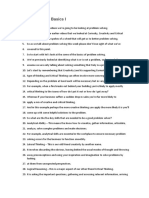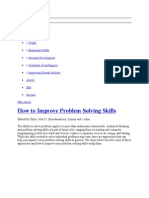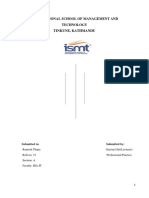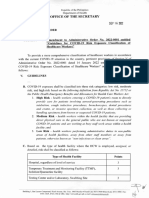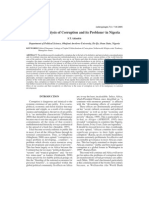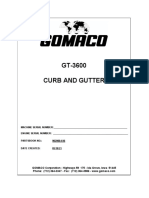• Introduction to Problem-Solving Skills
Good [morning/afternoon] everyone, and thank you for being here. Today, we’re going to explore a skill
that lies at the heart of innovation, engineering, and almost every field that seeks to make a positive
impact: problem-solving.
As engineering students, we often find ourselves facing complex challenges, whether it’s designing a
project, improving a process, or tackling unexpected obstacles in our studies. Problem-solving isn’t just
about finding answers—it’s about thinking critically, being creative, and sometimes even collaborating
to find solutions that are effective and sustainable.
In this presentation, I’ll take you through the key approaches to problem-solving, outline a step-by-step
process to tackle issues systematically, and share tools and techniques you can use to enhance this
essential skill. Whether you’re aiming to become a project manager, a design engineer, or any other
professional role, developing strong problem-solving skills will be a cornerstone of your success.
• Types of Problem-Solving Approaches
Analytical Thinking
Analytical thinking is the ability to break down complex problems into smaller, manageable
components. This approach is systematic and logical, allowing you to identify patterns, spot
inconsistencies, and understand how different factors relate to one another.
. Creative Thinking
Creative thinking involves generating innovative and unconventional ideas to solve problems. It’s about
thinking beyond the obvious solutions and coming up with ideas that might initially seem "outside the
box."
Creative thinking is essential when facing new or unique problems for which there isn’t a standard
solution. In engineering, creative thinking can lead to novel designs, process improvements, or even
entirely new technologies.
Example: Suppose you’re designing a new product. Creative thinking allows you to consider alternative
materials, unusual shapes, or non-traditional functions that could make the product more efficient or
appealing.
�3. Critical Thinking
Definition: Critical thinking is the process of evaluating information objectively, questioning
assumptions, and examining solutions from different angles to ensure they are feasible and effective.
Critical thinking helps engineers evaluate potential solutions by considering their practicality, cost,
safety, and impact. It’s essential for making informed decisions and avoiding biased or impulsive
choices.
• Steps in the Problem-Solving Process
Define the problem clearly.
Analyze the problem by gathering relevant data and understanding the root cause.
Generate possible solutions.
Evaluate each solution and select the most viable one.
Implement the chosen solution and monitor its effectiveness.
Include examples or case studies relevant to your field.
• Importance of Collaboration and Adaptability
Collaboration and adaptability are essential in problem-solving, especially in engineering, where
complex challenges often require diverse perspectives and skills. Working with others brings a range of
expertise and ideas, enabling more creative and well-rounded solutions. Adaptability, meanwhile, allows
teams to pivot and adjust their approaches when faced with unexpected obstacles or new information.
Together, these qualities help ensure that solutions are resilient, innovative, and effective even in
changing or uncertain environments.
• Improving problem solving skills
Why should
Improving problem-solving skills is crucial because it equips us to tackle challenges effectively, make
better decisions, and create innovative solutions in both our personal and professional lives. Strong
problem-solving abilities allow us to analyze situations critically, think creatively, and adapt to
unexpected issues, leading to more successful outcomes. In fields like engineering, where complex
�problems are common, honing these skills can significantly impact project success, efficiency, and even
long-term career growth.
how
Improving problem-solving skills involves a combination of practice, reflection, and seeking diverse
perspectives. Start by breaking down complex problems into smaller, manageable parts to make them
less daunting. Engage in brainstorming sessions, allowing yourself to think creatively and consider
unconventional solutions. Regularly challenge yourself with puzzles or real-world scenarios that require
critical thinking. Additionally, reflecting on past problem-solving experiences helps identify what
strategies worked and what didn’t, fostering a growth mindset. Collaborating with others can also
enhance your approach, as different viewpoints can lead to innovative solutions.








